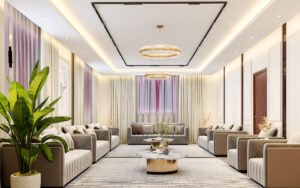Professional Design and Décor for Healthcare Facilities: Elevating Hospitals, Medical Centers, and
Clinics
In the ever-evolving landscape of healthcare, the design and décor of hospitals, medical centers, and
clinics play a crucial role in enhancing patient experience and operational efficiency. Professional
design not only addresses aesthetic appeal but also incorporates functional and psychological
aspects essential for a conducive healing environment. This article explores the principles of
designing and decorating healthcare facilities with an emphasis on creating spaces that promote
well-being, comfort, and operational effectiveness.
The Importance of Professional Design in Healthcare Facilities
The design of healthcare facilities impacts various elements, including patient satisfaction, staff
efficiency, and overall operational success. A well-thought-out design integrates functionality with
aesthetics to create spaces that are welcoming, safe, and efficient.
1. Designing for Patient Comfort and Well-Being
Incorporating patient-centered design principles is essential for enhancing comfort and reducing
anxiety. Key considerations include:
-Warm and Inviting Environments: Use of soothing color palettes, natural light, and comfortable
furnishings can make spaces more welcoming. Incorporating elements of nature, such as indoor
plants or water features, can contribute to a calming atmosphere.
– Wayfinding and Accessibility: Clear signage and intuitive layout are critical for guiding patients and
visitors. Design elements should include easily navigable pathways, accessible entrances, and clear
directional signage to ensure a smooth and stress-free experience.
– Privacy and Dignity: Designing patient rooms and waiting areas with privacy in mind helps maintain
dignity and reduce stress. Incorporating partitions or curtains and using soundproof materials can
enhance privacy.
2. Optimizing Functional Design for Medical Efficiency
Efficiency in medical facilities is achieved through thoughtful design that supports operational
workflows:
– Workflow Efficiency: Layouts should support the efficient flow of patients and staff. Design
considerations might include strategic placement of equipment, easy access to essential supplies,
and clear separation of different functional areas such as examination rooms, laboratories, and
administrative spaces.
– Safety and Infection Control: Healthcare design must prioritize safety. This includes selecting
durable, easy-to-clean materials and incorporating infection control measures such as proper
ventilation, antimicrobial surfaces, and seamless flooring.
– Staff Well-Being: Designing spaces that cater to the needs of healthcare professionals can improve
job satisfaction and productivity. Considerations include providing comfortable break rooms,
adequate storage solutions, and ergonomic workspaces.
3. Creating a Positive Aesthetic Experience
Aesthetic elements contribute significantly to the overall ambiance of healthcare facilities:
– Modern and Professional Aesthetics: Incorporate contemporary design elements that reflect a
professional and clean image. Use high-quality materials and finishes to enhance the visual appeal
and durability of the spaces.
– Personalization and Branding: Integrate elements that reflect the facility’s identity and values. This
might include branded colors, artwork, or thematic décor that aligns with the mission and vision of
the healthcare provider.
– Sustainability and Eco-Friendly Design: Consider incorporating sustainable design practices, such as
energy-efficient lighting, low-VOC paints, and eco-friendly materials, to create environmentally
responsible spaces.
خاتمة
Professional design and décor in hospitals, medical centers, and clinics are pivotal in creating
environments that foster patient well-being, enhance operational efficiency, and reflect a
professional image. By focusing on patient comfort, operational efficiency, and aesthetic appeal,
healthcare facilities can provide a more positive experience for patients and staff alike.
Engaging with expert designers who understand the unique requirements of healthcare
environments can lead to the creation of spaces that are not only functional and efficient but also
nurturing and welcoming. As the healthcare industry continues to evolve, the role of professional
design in shaping effective and empathetic healthcare environments becomes increasingly
important.
For healthcare facilities looking to enhance their design and décor, consider partnering with
professionals who specialize in creating optimal environments that support both patient care and
operational excellence.


